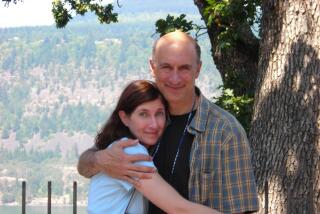Sometimes, Letting Go Is the Right Thing to Do
- Share via
When Gail Shafarman’s stepfather collapsed in her arms at his home, her first thought was that she didn’t want him to die. At the same time, she knew it was time. She had flown from Oakland to West Palm Beach, Fla., because his health had declined dramatically and, at 85, her beloved stepfather, Joe, was in fact dying.
But when the moment came and he suddenly stopped breathing, she panicked. “I was holding him, and I felt he was dead,” she said. “I had seen people die before. It looked like he might have had a stroke. He went rigid.” She yelled to her mother to call 911. Equally confused, her mother complied.
By the time the paramedics arrived, Shafarman and her mother realized they had made a mistake. Joe had a “living will” that specified “no heroic measures” be used to save his life. “We didn’t know that once you call the paramedics, they have a mandate to revive or do what they can,” said Shafarman, a psychologist.
She loved Joe, a man who had taught her to waltz and to do the twist, who was there in ways her birth father had never been. Neither she nor her mother had been prepared to let him go.
Revived, brain damaged by oxygen deprivation, Joe was angry, resentful and unsure whether he was dead or alive. He complained nightly that he hadn’t been able to pass through “the second door.”
One reason families are shocked even by an expected death is that they still hold attitudes left over from an era when people died quickly from infections or accidents. They don’t know how to react to lingering deaths, explained Joanne Lynn, director of Washington, D.C.’s Center to Improve Care of the Dying at George Washington University. Consequently, family members--and doctors too--wait until the last possible minute to acknowledge that a person is actually dying, thereby limiting the ability to understand choices, make plans or communicate specific wishes.
The denial of death can be exacerbated by emotional or geographic distance, so common that some people on the East Coast call it the “California daughter syndrome.” Guilt over separation makes it more difficult for those children to withhold lifesaving measures, even when they are futile.
If people could learn to see death more realistically, they could take greater advantage of hospice programs--comprehensive support and practical assistance to help people cope with the physical and emotional pain of dying.
Advocates say hospices provide ample pain control and offer people opportunities not only to make plans, but also to say goodbye, let go and resolve estrangements.
Currently, only 10% of Medicare patients die under hospice care because no one thinks of them as dying, only “very sick,” Lynn said.
Lynn’s center encourages healthy people with reasonably intact families to clarify their plans and preferences with family members and doctors. Many states, including California, allow paramedics to administer only comfort for those with advance directives.
Letting a loved one go can be emotionally wrenching, Lynn said. “But it’s terribly worthwhile. People manage to leave with such graciousness and self-understanding it almost surpasses words.”
It was three months before Joe died. Shafarman had gone back to California. This time, her mother did not call paramedics. Instead, she told Joe that she was ready to let go and that he could go, quickly now, through that second door.
* Lynn Smith’s column appears on Sundays. Readers may write to her at the Los Angeles Times, Life & Style, Times Mirror Square, Los Angeles, CA 90053. Please include a telephone number.
More to Read
Sign up for Essential California
The most important California stories and recommendations in your inbox every morning.
You may occasionally receive promotional content from the Los Angeles Times.













